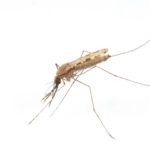Lien vers Pubmed [PMID] – 32105779
Lien DOI – S0965-1748(20)30028-X10.1016/j.ibmb.2020.103339
Insect Biochem. Mol. Biol. 2020 May; 120(): 103339
Hemocytes, the immune cells in mosquitoes, participate in immune defenses against pathogens including malaria parasites. Mosquito hemocytes can also be infected by arthropod-borne viruses but the pro- or anti-viral nature of this interaction is unknown. Although there has been progress on hemocyte characterization during pathogen infection in mosquitoes, the specific contribution of hemocytes to immune responses and the hemocyte-specific functions of immune genes and pathways remain unresolved due to the lack of genetic tools to manipulate gene expression in these cells specifically. Here, we used the Gal4-UAS system to characterize the activity of the Drosophila hemocyte-specific hemolectin promoter in the adults of Anopheles gambiae, the malaria mosquito. We established an hml-Gal4 driver line that we further crossed to a fluorescent UAS responder line, and examined the expression pattern in the adult progeny driven by the hml promoter. We show that the hml regulatory region drives hemocyte-specific transgene expression in a subset of hemocytes, and that transgene expression is triggered after a blood meal. The hml promoter drives transgene expression in differentiating prohemocytes as well as in differentiated granulocytes. Analysis of different immune markers in hemocytes in which the hml promoter drives transgene expression revealed that this regulatory region could be used to study phagocytosis as well as melanization. Finally, the hml promoter drives transgene expression in hemocytes in which o’nyong-nyong virus replicates. Altogether, the Drosophila hml promoter constitutes a good tool to drive transgene expression in hemocyte only and to analyze the function of these cells and the genes they express during pathogen infection in Anopheles gambiae.


